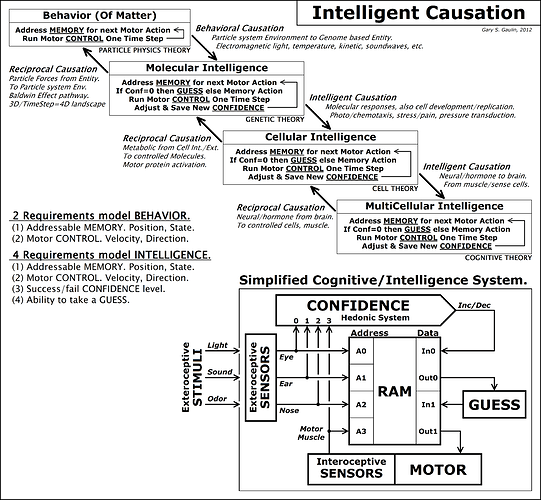Although the physics and chemistry can ultimately become daunting my strategy has been to start at the origin of life, primordial cognitive systems. For another forum I had to write about this and thought you might like to read it too. This concerns the emerging branch of science cognitive biology and contains the primary features of a HTM system, where for molecular dynamics particle behavior a SDR representing a particle’s local environment would be used, but the particle would not have to make predictions, only needs pretrained behavior typical of atoms or molecules:
The full model/theory I have is rooted in “behavior of matter”, science of physics. This is where its algorithm becomes an unintelligent molecular dynamics simulator for creating (never seen before) RNA World critters and observing their “evolution”.
A brief outline of how a system meets the four requirements helps sort out the primary components that need to be coded. For example self-replicating RNA:
Unimolecular Level Intelligence
Clues to the origin of intelligent living things are found in rudimentary molecular systems such as self-replicating RNA. Since these are single macromolecules that can self-learn they are more precisely examples of “Unimolecular Level Intelligence”, as opposed to “Molecular Level Intelligence”, which may contain millions of molecules all working together as one.REQUIREMENT #1 of 4 - SOMETHING TO CONTROL
The ribonucleotide sequences are a memory system that also acts as its body. The motor muscles of RNA are molecular actuators, which use the force of molecular attraction to grab and release other molecules. The catalytic ability (chemically reacts with other molecules without itself changing to a new molecular species) of ribonucleotide (A,G,C,U) bases combine to form useful molecular machinery. Where these bases are properly combined into strands they become a mobile molecule that can control/catalyze other molecules in their environment and each other, including using each other as a template to induce each others replication. Unlike RNA that exists inside a protective cell membrane (as our cells have) these RNA’s are more directly influenced by the planetary environment, which they would have once have been free to control. Modern examples include single strand (ssRNA) viruses that can control the internal environment of their host and may now have protective shells with sensors on the outside for detecting other suitable host cells to enter and control, for the purpose of reproduction. In some cases after invading a host cell other sensors can detect when conditions are right to simultaneously reproduce, thereby overwhelming the immune system of their hosts, which could otherwise detect then destroy them.REQUIREMENT #2 of 4 – SENSORY ADDRESSED MEMORY
On it are molecular sites, which can interact with nearby molecules to produce repeatable movements/actions. Its shape can include hairpin bends that are sensitive to the chemical environment, which in turn changes its action responses to nearby molecules and to each other.
A variety of properly ordered molecular species can easily be produced by wind/water motion or wet/dry cycles, resulting in quadrillions of different combinations all being tried in all the environments where the stuff of life in great quantities constantly accumulates, such as deep basins and via “skimming” onto ocean shorelines. Their combined activity also changes their molecular environment, much the same way as living things have over time changed the atmosphere and chemistry of our planet.REQUIREMENT #3 of 4 - CONFIDENCE TO GAUGE FAILURE AND SUCCESS
Molecular species that can successfully coexist with others in the population and the environmental changes that they caused are successful responses that remain in the population. Molecular species that fail are soon replaced by another more successful (best guess) response. The overall process must result in collective actions/reactions that efficiently use and recycle the resources available to multiple molecular species or else there is an unsustainable chemical reaction, which ends when the reactants have consumed each other, resulting in an environmental crash.REQUIREMENT #4 of 4 - ABILITY TO TAKE A GUESS
For a rapidly replicating molecule RNA editing type mechanisms can become a significant source of guesses. Also, molecular affinity will favor assimilation of complimentary ribonucleotides but where some are in limited abundance another ribonucleotide may replace what was previously used. The change may work equally well, or better, for their descendants.
In this illustration you can see how at the top level the behavior of a particle simply depends on forces around it. In a stream of flowing water unintelligent particles get carried with the flow, they have no ability to choose to swim upstream:
After (from hydrogen) stars created heavier elements increasingly complex chemical/molecular species were (by behavior of matter) created. This illustration shows resulting biological speciation:
At some point in the process was creation/emergence of molecular self-learning systems, which in turn took over the planet including deep inside. Cognitive biology is this way shown to have begun with an “origin of life” that predates DNA based cells and started with the most primordial “cognitive” system of them all.

